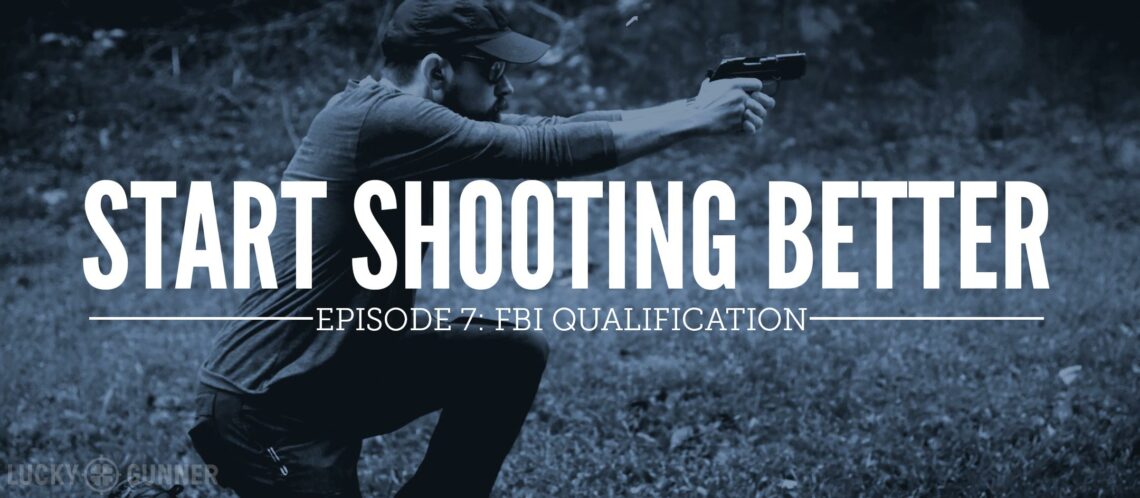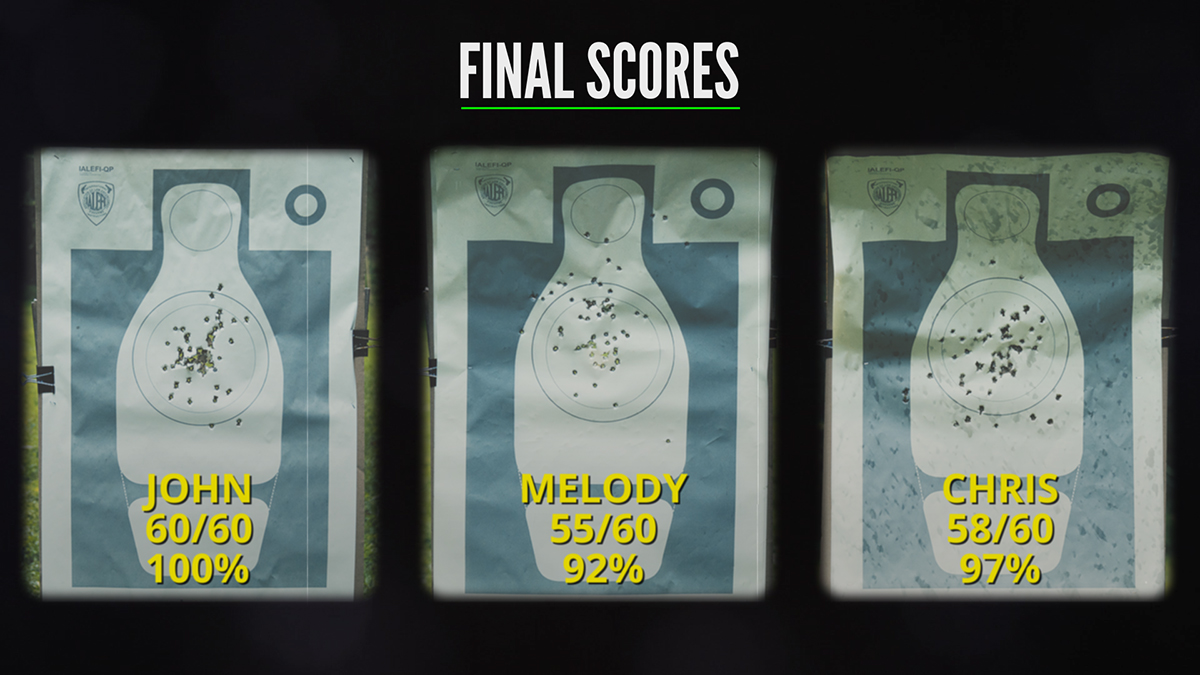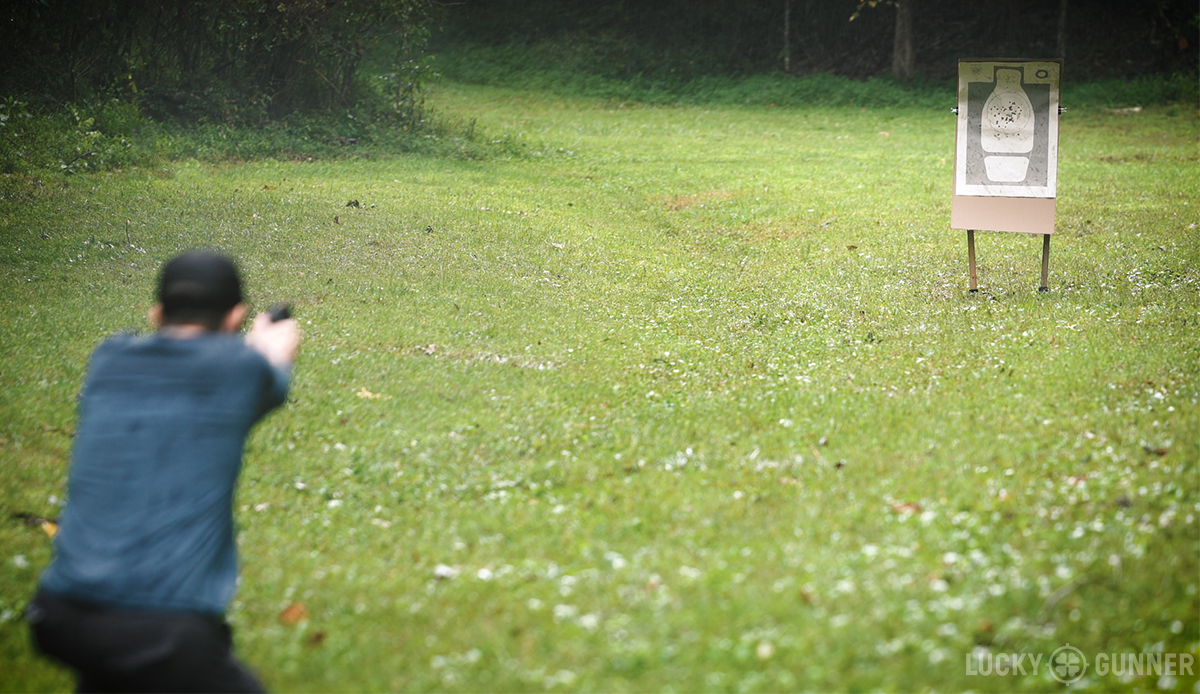It’s time for another action-packed installment of Start Shooting Better! This time, John and I walk through the FBI Qualification test that all FBI agents are required to pass in order to carry a firearm on duty. While it’s not necessarily an ideal tool for skill development, there are a lot of benefits for the average armed citizen in being able to demonstrate that they can pass a federally recognized shooting standard. Watch the video below for details (or scroll down for the transcript) and give it a try the next time you’re at the range.
CHRIS: Hey guys, I am Chris from Lucky Gunner and welcome back to another episode of our Start Shooting Better series. In this series, we’re showing you different drills and tests that you can do at the range to help improve your overall shooting ability. I’m here again with John Johnston from Citizen’s Defense Research and the host of Ballistic Radio. Today we are looking at the current FBI qualification. So John, why don’t you give me a general outline of what that looks like.
JOHN: So it’s a 60 round qualification that pretty much has all the skills that the FBI has decided is important for their agents to be able to exhibit in the shootings that they run into. So we’ve got everything from draw to shot, weak hand only transfers, reloads, and shooting behind cover — stuff like that from distances of 3 yards to 25 yards.
CHRIS (VOICE OVER): The FBI Qualification consists of 60 rounds fired over 8 stages. The starting point for all stages requires the gun to be in a concealed holster. You can use any target with the FBI QIT reduced silhouette. For our demo runs today, we’re using the IALEFI-QP target, so our scoring zone will be this whole upper portion of the silhouette. Shooters need to get at least 80% of their hits somewhere on the silhouette in order to pass. Each stage has a time limit and any shots fired over that time limit count as misses.
Stage 1: From 3 yards in 3 seconds, draw and fire three rounds with the strong hand only. Do this stage 2 times.
Stage 2: From 3 yards in 8 seconds, draw, fire 3 rounds with the strong hand only, then transition the gun to the support hand and fire 3 more rounds.
Stage 3: From 5 yards in 3 seconds, draw and fire 3 rounds. Do this stage 4 times.
Stage 4: From 7 yards in 4 seconds, draw and fire 4 rounds. Do this stage twice.
Stage 5: From 7 yards in 8 seconds, draw, fire 4 rounds, perform an emergency reload, and fire 4 more rounds.
Stage 6: From 15 yards in 6 seconds, draw and fire 3 rounds. Do this stage twice.
Stage 7: From 15 yards in 8 seconds, draw and fire 4 rounds.
Stage 8: Starting a few feet behind the 25 yard line, in 15 seconds, take one step forward, draw and fire 2 rounds from a standing position, then transition to a kneeling position and fire 3 more rounds. Do this stage twice.
The official version of the FBI test calls for the shooter to fire from behind cover this stage, but that’s difficult to set up at a lot of ranges, and it really shouldn’t have a huge impact on your score if you go without it.
For our demo runs, John, Melody, and I were all able to complete each stage within the time limits. John got 60 out of 60 for a perfect 100% score. Melody shot 55 out 60, which is a score of 92%. And despite the rain, I managed to get 58 out of 60 for a 97% score.
CHRIS (TO JOHN): So what do you think are some advantages to running a test like this?
JOHN: It’s really nice for the armed citizen just because it is a nationally recognized standard that, if you can meet it and you are ever called into court for whatever reason, you can say, “I’m able to meet the standard the FBI sets for their agents.”
CHRIS: Do you think there’s any benefit to running this test and having someone observe you who can verify that you’re able to do it?
JOHN: Yeah, so that’s the other thing — if you go out in your backyard and shoot this and you don’t have anyone to watch it, having on video wouldn’t be a bad idea. Having someone to run the timer and put their name on it, too — better yet, go and take it when you’re at a class or something like that. I know Tom Givens runs this from time to time depending on what the class is, Melody and I at Citizens Defense Research run it. There’s a bunch of quality instructors that will run you through this test and keep track of it. That’s something that we do — we take a picture of the student standing next to their target and keep it on file just for that reason.
CHRIS: So how would you compare something like this to the average state level concealed carry qualification?
JOHN: It is much more difficult… which is actually sort of scary because it’s, honestly, an easy qual to pass.
CHRIS: So that leads to my next question, because I know you’ve got some criticisms of this test. Where do you think it falls short?
JOHN: The time standards are really generous, I think. If you, even a little bit, know what you’re doing, you’ve got plenty of time to conduct that. And also, and we’ve got one of the targets right here, the scoring zone you’re shooting at is relatively large and generous and I’d like to see a smaller scoring zone.
CHRIS: So this is a cardboard IDPA target and we’ve painted over it with the Q target silhouette that you’d be shooting at for the FBI qual.
JOHN: Right, and as you can see, it’s very generous. It’s essentially the -1 and the -0 area on one of those targets.
CHRIS: And normally we want to keep our shots tighter, like an 8-inch circle at the very…
JOHN: At the very most. What I would actually like to see people be able to do is if you imagine a 4-inch wide by 6-inch tall rectangle and put it somewhere in [the upper chest area] on somebody — I’d like people to be able to hit that from pretty much 3 yards to 25 yards in reasonable times. That would be the goal. I can’t always do it, but that’s what I’m trying to do.
CHRIS: Okay, so 80 out of 100 score — so how many shots does that mean you can actually drop while you’re shooting the test and still pass?
JOHN: Twelve. It’s a 60 round qualification and you can drop 12 of those and still shoot an 80% which is the standard that agents are required to hit. If you want to shoot an instructor score, you have to shoot 90% or above. Now I will say this — if you’re running it with something like a 5-shot J-frame or a Glock 42, it’s starting to get a little more difficult, but still passable. Really, the only thing that would be problematic for people at that point is the strong hand only/weak hand only stage just because of the round requirement, if you were running a J-frame, and then the reload stage.
CHRIS: Right, because it’s designed around shooting a service-size, or maybe a compact firearm.
JOHN: Yeah, it’s designed around shooting a Glock 22 or a Glock 23 and now they’re moving to 17s and 19s, but either way, that size firearm.
CHRIS: If somebody tries out this drill and they just flat out can’t come anywhere close to the qual, what would be your suggestion for their next step?
JOHN: It would depend on what the issue was. So if they’re dropping a ton of shots, where are they dropping the shots? If you’re dropping shots — and I’m sorry, this isn’t going to make everyone happy — if you’re dropping shots close, then you really need to work your fundamentals because there’s something going on that’s majorly wrong. If you’re running long on some of the times, then you need to work quicker hands and getting the gun out and accessing it with a little more rapidity. If where you’re dropping shots is at longer distances, then once again, focus on the fundamentals. All this stuff is the basic fundamentals of marksmanship just applied at speed and there’s no secret sauce to that, it’s just — you gotta work at it.






Excellent I am going to try this.
Looks like the Federales are still in the mid-20th century. The course is a revolver course, very similar to the PPC police course I fired in the 1970’s. There is no string of fire that exceeds 6 rounds without a reload. That’s not realistic with normal capacity semi-auto pistols. It’s important to fire the full capacity of the pistol, run it dry and reload once in a while.
I hope beyond this course the agents train using their pistols at full capacity. It’s been demonstrated time and again, sometimes tragically; “You fight as you train.” If you train to fire 6 shots and stop, or reload after 6 rounds, that’s they way you will fight, throwing away most of your ammo.
Being retired LEO, I shoot a very similar course for my annual HR218 qualification. The difference being we must score 100% to qualify. A friend of mine, also retired LEO firearms instructor, has shot this course blind-folded.
The Bu’ actual training is very pragmatic. They, too, believe you fight like you train, so they train to a much higher standard than just meeting the qual. The qual itself, however, as you observe, hasn’t been updated in forever.
The _initial_ training agents receive in shooting at Quantico start with core fundamentals and trigger training until your fingers are ready to fall off, range training and presentation drills averaging 1000+ rounds per day (under heavy observation from excellent instructors, so as not to reinforce bad habits). That continues five days a week for 17 weeks, covering multiple positions (standing, kneeling, sitting, prone front and back, supported, unsupported, cover, no cover, strong side, weak side for all, etc), reloads, transitions, weapons failures, brutal weapons retention drills and more. In addition to range time, this is all carried into and continued with myriad real world training scenarios in Hogan’s Alley with simunition (which hurts, even through a vest, so nobody gets complacent, and which works, but fails enough to require fast action drills under stress).
In addition to pistol, they also train extensively with shotgun, mp5 platform (though this was being transitioned last I heard), and carbines (m4 platform).
Once initially qualified, agents are expected to continue with weekly range time, and periodic refreshers, not just periodically prequalify by shooting the actual qual.
There is also more advanced training types available beyond that initially received. Some agents take HRT training even if they’re not assigned to HRT, and so on. It’s definitely _not_ the ‘box of ammo per year and an annual qualification’ that some local and state departments are allotted.
Reloads are important and the criticism that this course doesn’t require reloads is a valid one but quite easy to negate. Don’t allow magazines to be loaded beyond the number of rounds needed at the stage being fired. Problem solved.
BTW, every bit of research into both police officer involved shooting incidents and shooting incidents in general indicates that in the stress of the situation almost no shooter counted their shots and those few who did count their shots very seldom did so accurately. The idea then that someone who trains on this course would fire six shots and then dump a magazine that still contains more rounds in a real shooting is dubious at best.
The ole “stand and deliver” how bout shoot on the fly like the real world does
The main thing about this course is that it’s the FBI’s. In court if it is challenged, The FBI can be called to testify as to it’s validity. Let the other side go against the 800 lb. gorilla.
The only negative I see is some lawyer for the persecution saying “passing the FBI course once does not guarantee passing it always”. Adding, if a millennial, the shooter must be a racist with white privileged
Where did you get your targets?
A shooter who passes this (or any police agency’s pistol qualification course) hasn’t proven anything except MINIMAL competence. That’s not an insult, it’s just a fact. I’ve shot this exact course- meeting or beating all time requirements and including the reloads- multiple times with a 2″ J-frame S&W five shot revolver firing DAO. On my worst day ever I threw four shots for a score of 94% and I consider myself a just slightly above average shooter.
Anyone wanting to a more realistic test on this course can do so if they have a large enough range to set up fifteen targets. Simply add one more time requirement and reverse the stage order. While moving from target to target complete the entire course in under two and a half minutes.
When I qualified for armed security work in North Carolina in 2016 we did slightly more shooting. It involved 150 rounds at those same range points however we did kneeling and prone as well as standing. And ours was drawn from open carry hip holster because that’s how worked. It also involved a standing course at night. I shot 100 on daytime and 89 on night which passed with my standard Beretta 92FS I’ve had and shot for 25+ years. They issued Glocks and I’m not a fan of Glock.
As long as I had that job on payday I would get 150 rounds and 3 targets and go to a near by outdoor range and shoot what drills I could. I agree with another poster here the qualification is just a start. You need to practice as much as time and finances allow. If you can get further training.
Molon Labe!
Keep your powder dry and your faith in God.
Surprisingly easy. I dropped one out of the 60 rounds out of the zone, and had time to spare in every stage. I think it actually hurt my shooting to have too much time at the further distances, I began to think about it instead of just firing as soon as my sight picture came back on target. I also learned that I shoot better standing than kneeling, which surprised me, but only because I never kneel. I just figured it would be more stable but nope. I suppose if I practice it, it could become more stable than kneeling, but I think I’d just squat behind cover rather than go to a knee, unless I was gonna park there for a while. Good to know that the practice I’ve been doing prepared me to more than qualify on the FBI eval. Thanks for showing us this exercise.
The Amerikan FBI is a failed and incompetent Third World political police force. This is why I train ONLY to Spetsnaz Qualifications.
Given the overall poor shooting street performance on record for our dedicated, brave (and I mean that -no sarcasm intended whatsoever!) police officers, why are we looking to their training and qualification courses as models, instead of coming up with better ones? I’ve spent a good portion of my over 35 years as a university professor teaching nurses and and other health professionals, and if my training methods led to a lower than 25% success rate, I’d change them, or look for another job.
One option occurs to me. Because life rarely serves us up anything predictable, training should likewise tend to run off the rails to some degree. As we gain more and more experience, training and qualifying should toss us more and more curve balls, until “we expect the unexpected.” Everytime we see lemons coming our way, we should think, “lemonade!” We made it through the past several million years by using a hunter’s brain, and in these circumstances, nothing has changed except the tools we employ.
The qualification is kind of like a certificate of diploma. Did anyone ever see the movie “Good Will Hunting”? I’ll assume someone got my point. I never tried the qualification. I don’t have the luxury of the facilities depicted in the video. Does anyone think that scoring a 78% would be of any comfort to the target (assume for the sake of argument the target is alive)?
” i passed the FBI qualification, and you didn’t. ”
“You must be very proud, congratulations. But in fact I never took the test.”
” Well, you don’t know how to shoot! ”
“Whatever…..but then, I don’t recall asking you anything. You have a nice day.”
Excellent Chris. Thank you.